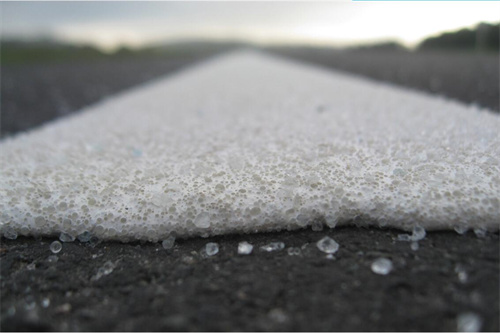
Overview:
In the realm of road safety, reflective glass beads play a crucial yet often overlooked role. These tiny spheres of glass are the unsung heroes that make road markings visible at night, enhancing safety for drivers, cyclists, and pedestrians alike. This comprehensive guide will explore the world of reflective glass beads used in thermoplastic road marking paint, delving into their properties, applications, and why they’re essential for modern road infrastructure. Whether you’re a traffic engineer, a road safety enthusiast, or simply curious about how our roads stay visible after dark, join us as we illuminate the fascinating world of reflective glass beads in thermoplastic road marking paint!
What Are Reflective Glass Beads for Thermoplastic Road Marking Paint?
Reflective glass beads for thermoplastic road marking paint are small, spherical particles made from high-quality glass. These beads are designed to be partially embedded in the surface of road markings, where they serve a critical function: retroreflection.
Picture millions of miniature glass marbles, each no larger than a grain of sand, scattered across the surface of road lines and symbols. When light from vehicle headlights hits these beads, it’s reflected back towards its source, making the road markings bright and visible to drivers at night or in low-light conditions.
The production of these glass beads is a fascinating process. High-purity silica sand is melted in furnaces at temperatures exceeding 1500°C (2732°F). The molten glass is then atomized into tiny droplets, which naturally form into spheres due to surface tension as they cool and solidify in mid-air. It’s like watching a microscopic fireworks display of molten glass transforming into a shower of perfect, reflective spheres!
What sets reflective glass beads apart from regular glass is their optical clarity, uniform spherical shape, and specific refractive index. These properties are carefully controlled to ensure maximum retroreflection, making road markings highly visible even in challenging conditions like rain or fog.
The Science of Retroreflection
The effectiveness of reflective glass beads in road markings is rooted in the principle of retroreflection. When light enters a glass bead, it’s refracted (bent) and then reflected off the back of the bead, sending it back in the direction it came from. This is why road markings appear to “light up” when illuminated by headlights, even though they don’t have their own light source.
The spherical shape of the beads is crucial for this effect. It ensures that light is reflected back towards its source regardless of the angle at which it hits the bead. This is like having millions of tiny cat’s eyes embedded in the road, all working together to guide drivers safely along their path.
Specifications and Standards: Measuring Quality in Reflective Glass Beads
When it comes to reflective glass beads for thermoplastic road marking paint, quality and consistency are paramount. The best glass beads adhere to stringent specifications and standards. Here’s what you should be looking for:
| Specification | Details |
|---|---|
| Type | Solid glass microspheres for retroreflective road markings |
| Composition | Typically >65% SiO2, with other oxides for specific properties |
| Attributes | Spherical shape, transparent, colorless |
| Characteristics | Refractive Index: 1.5-1.9, Specific Gravity: 2.4-2.6 g/cm³ |
| Specifications | Size range: 100-850 micrometers; Roundness: >80%; Defects: <20% |
| Dimensions | Various grades available, typically ranging from 100-850 micrometers in diameter |
| Grades | Type I (standard), Type II (high-index), Type III (wet-reflective) |
| Standards | Complies with AASHTO M247, EN 1423, BS 6088, and other international standards |
A reputable supplier of reflective glass beads should be able to provide detailed specifications for their products and explain how their beads meet or exceed industry standards. It’s like buying high-performance tires for your car – you want to know all the specs and be sure they meet safety standards before making your purchase.
The size distribution, roundness, and refractive index of the beads are particularly crucial. Size affects the embedment in the paint and the resulting retroreflection, roundness ensures consistent optical performance, and refractive index determines the intensity of the retroreflection. A quality supplier will have strict quality control measures in place to maintain these properties consistently across large batches.
Applications: From Highways to Helipads
Reflective glass beads for thermoplastic road marking paint have a wide range of applications in transportation infrastructure. Let’s explore where these tiny spheres make a significant impact:
Application:
- Highways and Freeways: Lane markings, edge lines, center lines
- Urban Roads: Crosswalks, stop lines, directional arrows
- Airports: Runway markings, taxiway lines, apron markings
- Parking Lots: Parking space lines, directional arrows, pedestrian crossings
- Bike Lanes: Dedicated bicycle path markings
- Construction Zones: Temporary lane markings and detour signs
- Heliports: Landing pad markings
- Industrial Facilities: Warehouse floor markings, safety lines
- Sports Facilities: Field and court markings for nighttime use
- Marine Applications: Port facility markings, boat ramp lines
From the high-speed environment of highways to the precise requirements of airport runways, reflective glass beads play a crucial role in ensuring visibility and safety. In urban settings, they help protect pedestrians at crosswalks and guide cyclists in dedicated lanes. Even in industrial settings, they contribute to safety by clearly marking paths and zones.
A high-quality supplier of reflective glass beads should be able to provide beads suitable for all these applications and more. They should understand the specific requirements for each use case and be able to recommend the right product for the job.
Weighing the Pros and Cons
When considering a supplier of reflective glass beads, it’s important to weigh the advantages and limitations. Let’s break it down:
| Pros | Cons |
|---|---|
| Consistent quality for reliable retroreflection | May have high minimum order quantities |
| Often offer beads with different refractive indices | Potential for longer lead times on specialized beads |
| Usually have comprehensive quality control | Storage can be challenging for smaller buyers |
| Environmentally inert and recyclable | Initial cost may be higher than non-reflective alternatives |
| Long lifespan when properly applied | Performance can degrade if not properly maintained |
While the pros generally outweigh the cons for most road marking applications, it’s important to consider these factors when choosing a supplier of reflective glass beads for your specific needs.
Why Choose LANXING?
When it comes to selecting a supplier of reflective glass beads for thermoplastic road marking paint,
LangFang Lanxing Impex Co., Ltd stands out from the competition. Here’s why:
- Quality Assurance: With ISO 9001 and CE certifications, LangFang Lanxing Impex Co., Ltd demonstrates a commitment to quality that meets international standards. Their glass beads consistently meet or exceed industry specifications for size distribution, roundness, and refractive index.
- Competitive Pricing: Offering prices ranging from $800 to $1200 per ton, they provide excellent value for money without compromising on quality or performance.
- Flexible Order Quantities: With a minimum order quantity of just 1 ton, they cater to both large infrastructure projects and smaller local road maintenance tasks.
- Quick Delivery: Their 7-14 day delivery time is among the fastest in the industry, ensuring your road marking projects can proceed without delays.
- Extensive Product Range: LangFang Lanxing Impex Co., Ltd offers a wide range of glass bead sizes and types, including standard, high-index, and wet-reflective beads suitable for various road marking applications.
- Technical Support: Their team of experts can provide guidance on selecting the right glass beads for your specific application, ensuring optimal retroreflection and longevity.
- Environmentally Friendly: Their glass beads are inert and recyclable, aligning with growing environmental concerns in infrastructure development.
Practical Tips for Using Reflective Glass Beads in Thermoplastic Road Marking Paint
To get the most out of your reflective glass beads in thermoplastic road marking paint, consider these practical tips:
- Proper Application: Ensure the beads are applied immediately after the paint while it’s still wet. This allows for optimal embedment and maximizes retroreflection.
- Bead Distribution: Aim for an even distribution of beads across the painted surface. Over-application can lead to waste, while under-application reduces visibility.
- Embedment Depth: Ideally, beads should be embedded to about 60% of their diameter. This provides the best balance between retroreflection and durability.
- Paint Compatibility: Ensure the beads are compatible with your thermoplastic paint. Some paints may require specific types of beads for optimal adhesion and performance.
- Weather Considerations: Apply road markings in dry conditions for best results. Moisture can interfere with bead adhesion and embedment.
- Regular Maintenance: Implement a regular inspection and maintenance schedule to ensure continued performance of the road markings.
- Safety First: Always follow proper safety protocols when applying road markings, including using appropriate personal protective equipment (PPE) and setting up proper traffic control measures.
FAQs: Shedding Light on Common Questions
Q: What are reflective glass beads used for in thermoplastic road marking paint?
A: Reflective glass beads are used to enhance the visibility of road markings by reflecting headlights, making road lines and symbols highly visible at night and in low-light conditions, thus improving road safety.
Q: How do reflective glass beads improve the visibility of road markings?
A: Reflective glass beads embed into the thermoplastic paint surface and reflect headlights back towards drivers, significantly increasing the brightness and visibility of road markings during night or adverse weather.
Q: What sizes are available for reflective glass beads used in road marking paint?
A: Reflective glass beads come in sizes ranging from 100 to 850 microns. Smaller beads are used for fine lines and detailed symbols, while larger beads are preferred for thicker lines and areas needing higher visibility.
Q: Are reflective glass beads durable and long-lasting?
A: Yes, reflective glass beads are made from high-quality, durable glass that withstands traffic and weather conditions, maintaining their reflective properties and ensuring long-lasting visibility of road markings.
Q: How are reflective glass beads applied to thermoplastic road markings?
A: Reflective glass beads can be applied by the drop-on method, where beads are sprinkled onto hot paint, or the premix method, where beads are mixed into the paint before application, ensuring even distribution and reflectivity.






